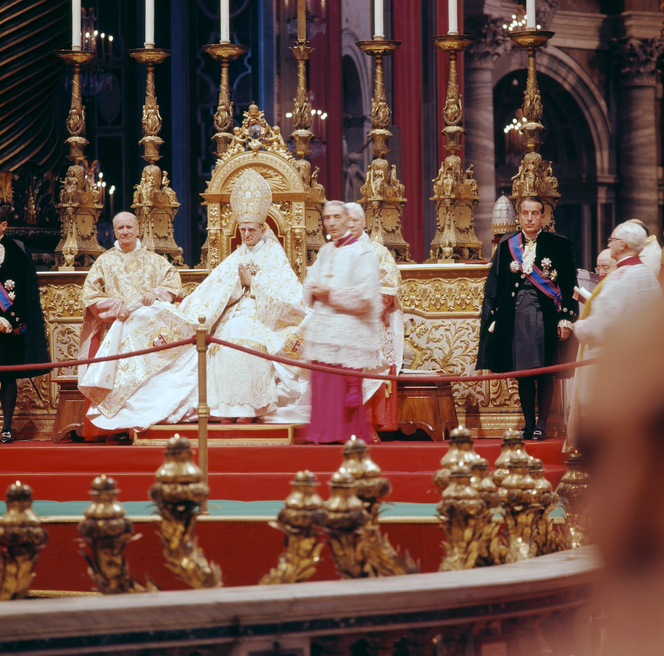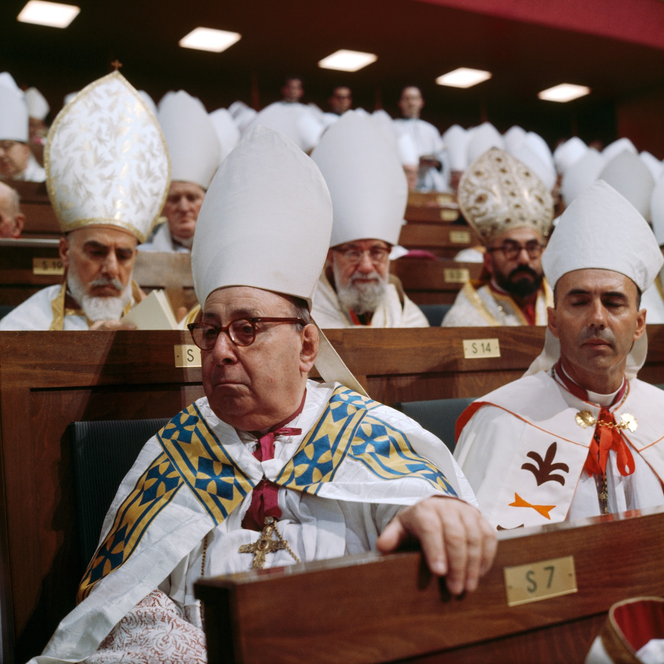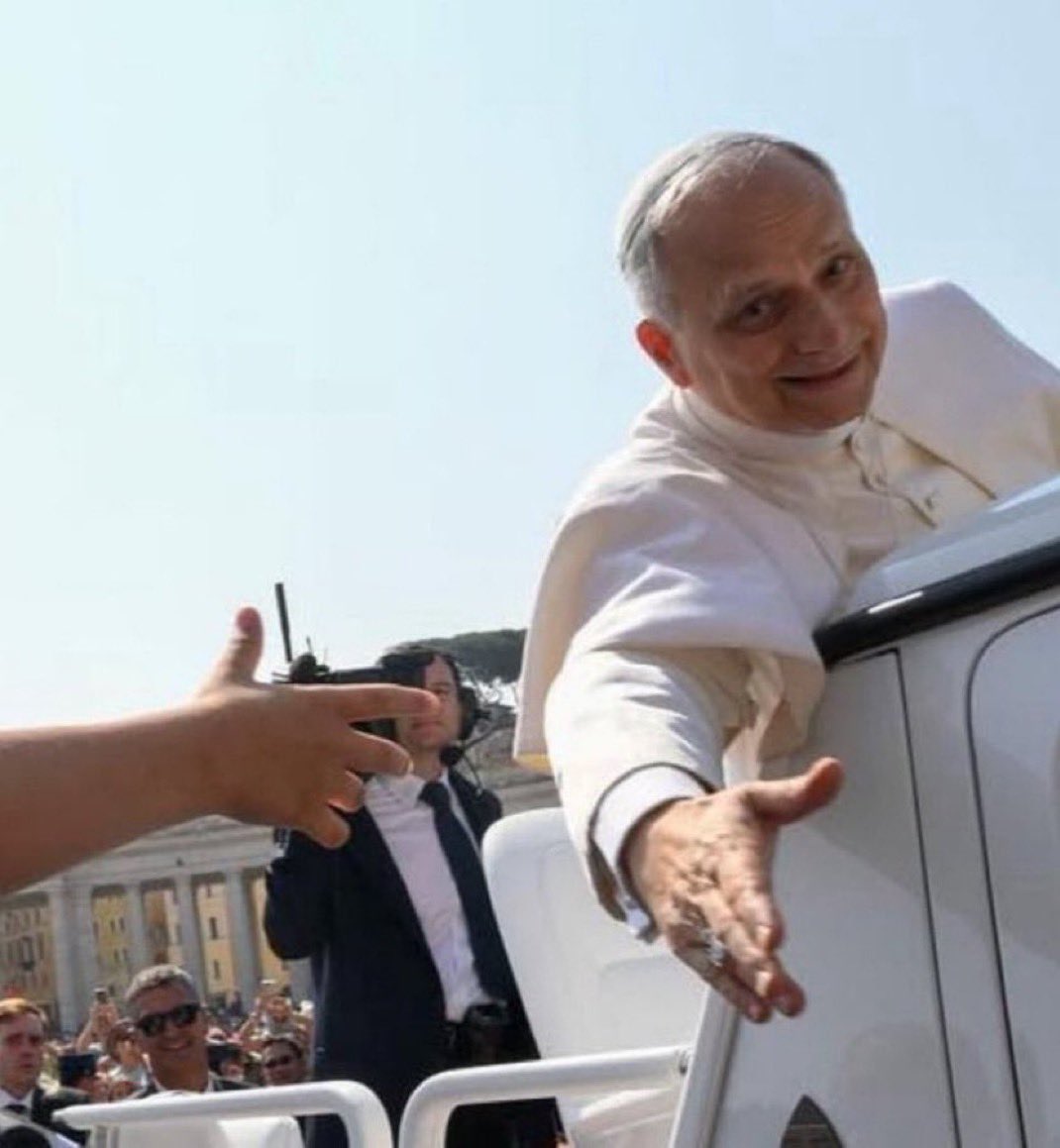The Modernist Robber Synod dismantled…
The Theological Errors of the Second Vatican Council
A Substantial Collection of Resources

The false pope Paul VI during Vatican II (1962-65)
The so-called Second Vatican Council convened from 1962 until 1965. It was called by the false pope John XXIII (Angelo Roncalli) and promulgated and concluded by his no less false successor, Paul VI (Giovanni Battista Montini).
Vatican II, as it is typically called for short, marks the definitive beginning of what we call the Novus Ordo religion and provides its doctrinal foundation. It is the be-all and end-all of the Modernist institution that has been occupying the Catholic structures since John XXIII usurped the Holy See at the 1958 conclave. Everything in the Counterfeit Church revolves around this accursed synod.
In fact, the council marks such a clear turning point in Catholic belief, worship, and practice that virtually everyone — except for a few conservative pipe-dreamers at Catholic Answers, EWTN, Franciscan University of Steubenville and similar places — readily admits that the “Catholicism” since the council is substantially different from the Catholicism prior to it. The so-called “hermeneutic continuity and reform” that is so often invoked, is a chimera, and pretty much everyone knows it.
The Novus Ordo theologian Fr. Francis Sullivan, for example, openly admits that
…on several important issues the council clearly departed from previous papal teaching. One has only to compare the Decree on Ecumenism with such an encyclical as Mortalium animos of Pope Pius XI, or the Declaration on Religious Freedom with the teaching of Leo XIII and other popes on the obligation binding on the Catholic rulers of Catholic nations to suppress Protestant evangelism, to see with what freedom the Second Vatican Council reformed papal teaching.
(Francis A. Sullivan, S.J., Magisterium: Teaching Authority in the Catholic Church [Mahwah, NY: Paulist Press, 1983], p. 157)
“Fr.” Thomas Guarino concedes this as well:
Surely the council represents a significant volte-face [about-face] on ecumenism. Mortalium animos casts doubt on the entire ecumenical enterprise, forbids Catholics from engaging in the movement, and comes close [sic] to calling Protestantism “a false Christianity, quite foreign to the one Church of Christ”… The Decree on Ecumenism [Unitatis Redintegratio of Vatican II], in contrast, warmly welcomes ecumenism, encouraging intelligent and active participation in it (UR §4). The discontinuity between the two documents is the source of consternation for some [sic] Catholics.
(Thomas G. Guarino, The Disputed Teachings of Vatican II: Continuity and Reversal in Catholic Doctrine [Grand Rapids, MI: William B. Eerdmans, 2018], pp. 108-109)
Guarino then proceeds to attempt to smooth over and justify this reversal, but that is beside the point now. The point is that there clearly is discontinuity, there is rupture, there is contradiction, between Vatican II and the preceding Magisterium.
A mere two weeks after the council opened, Cardinal Alfredo Ottaviani’s American theological advisor, Mgr. Joseph C. Fenton, wrote in his personal diary: “This is going to mark the end of the Catholic religion as we have known it” (entry dated Oct. 31, 1962). How right he was!
This is the same Mgr. Fenton who had battled “the Jesuit theologian John Courtney Murray over the latter’s unorthodox interpretation of church teaching on church-state relations”, Joseph M. White writes in his book The Diocesan Seminary in the United States: A History from the 1780s to the Present (p. 333; underlining added). And he continues: “Murray’s dissenting position was adopted in the Declaration of Religious Freedom at Vatican Council II in 1964, and Fenton’s positions have been eclipsed” (see scan here). In other words, Vatican II adopted the unorthodox position, whereas the Catholic position, defended by Fenton, was abandoned. What does that tell us?!
While he apparently tries to resolve contradictions in doctrine by waving the magic wand of “doctrinal development”, even the former “Fr.” Barry Hudock he agrees that Fr. Murray’s position on religious liberty “looked a lot to some people in 1954 (when Murray was silenced) and 1964 (when the council fathers debated his ideas) like a contradiction of doctrine.” Interestingly enough, what Hudock disputes in this controversy is not that there is a contradiction but that the prior teaching was doctrine: “Murray did depart from what had been commonly regarded as Catholic doctrine, and he knew it; but he insisted that it wasn’t the doctrine he was questioning but rather the historically conditioned expression of it” (Struggle, Condemnation, Vindication: John Courtney Murray’s Journey Toward Vatican II, pp. 171-172; all italics in original). This typical Modernist copout was condemned by Pope Pius XII, who called it “contempt of doctrine commonly taught, and of the terms in which it is expressed…” (Encyclical Humani Generis, n. 16).
In a newly-published academic work, Prof. Shaun Blanchard shows that Bp. Scipione de’ Ricci’s robber synod of Pistoia, Italy, which was strongly condemned by Pope Pius VI in the 1794 Apostolic Constitution Auctorem Fidei, in many ways anticipated the changes of Vatican II and the post-conciliar church. Blanchard acknowledges “striking similarities between some Vatican II reforms and the censured decrees of the [Pistoian] Synod” and elaborates:
The Pistoians had a rare sensitivity I call “proto-ecumenical” — Ricci and some in his circle preferred to speak of Protestants as “separated brethren”, not heretics. The Synod exalted the office of the bishop, and it proclaimed the pope to be a servant of unity, not a monarch. It saw infallibility as a charism given to the entire believing community. The Synod proclaimed that Bible reading was for all literate people, and the illiterate should have scripture read to them in their native language by priests. They discouraged, even banned, devotions that were not centered on Christ or biblically based. The Synod de-emphasized and reinterpreted indulgences, taught the priesthood of all believers, and declared active participation of lay people at Mass a right and duty. They clearly wished that public worship would predominantly be in the vernacular, not Latin. The Synod also praised Grand Duke Peter Leopold’s recent decree abolishing the Inquisition in Tuscany, and they implied religious liberty, or at least toleration, arguing that “the heart is not reformed with prison and fire.”
(Shaun Blanchard, The Synod of Pistoia and Vatican II: Jansenism and the Struggle for Catholic Reform [New York, NY: Oxford University Press, 2020], p. x)
Similarly, Dr. Jürgen Mettepenningen notes that the New Theology that was utilized to provide the theological underpinnings of the Second Vatican Council was the “inheritor of Modernism” and the “precursor of Vatican II”, as the subtitle of his book Nouvelle Théologie – New Theology says. Being a Modernist himself, Mettepenningen happily points out that “it took a council to give the movement a positive connotation after three decades of magisterial rejection” (p. xiii; italics added). Isn’t that the truth!
In 1946, Pope Pius XII had hit the nail on the head about this strange new theology that would thoroughly revolutionize what the world understands to be Catholicism: “Much has been said, but not enough after due consideration, about the ‘Nouvelle Théologie’, which, because of its characteristic of moving along with everything in a state of perpetual motion, will always be on the road to somewhere but will never arrive anywhere” (Allocution Quamvis Inquieti). Doesn’t this sound familiar? Now we know why in the Vatican II Church they’re “always in movement”!

The fateful council in session
It is necessary and useful, therefore, to take a concise look at the salient teachings and ideas put forward by the Second Vatican Council that stand in marked contrast and contradiction to the true Roman Catholic Church, her Magisterium, and all true Popes.
To this end, we have lined up the following free resources.
Bp. Sanborn’s Sermons on Vatican II (ca. 1993)
In the 1990s, then-Fr. (now Bp.) Donald Sanborn delivered a series of sermons presenting in accessible language and style, the chief heresies and errors of Vatican II, as well as their orthodox Catholic refutation. The audios of these sermons have been made available for free by True Restoration and can be accessed below. Notice that each episode includes two separate sermons and the final episode includes three.
As the presentations are very powerful, the content has been transcribed electronically. The transcripts are available for purchase from True Restoration — the links are given below, underneath each episode title.
Episode 1: “Substantial or Accidental Changes?” & “The Fundamental Error of Vatican II”
Order Transcript: HERE
Episode 2: “Ecumenism” & “Liturgical Changes of Vatican II”
Order Transcript: HERE
Episode 3: “Doctrinal Errors of Vatican II (Overview)” & “The Heresy of Lumen Gentium“
Order Transcript: HERE
Episode 4: “The Errors of the Decree on Ecumenism” & “The Error of Religious Liberty”
Order Transcript: HERE
Episode 5: “The Error of Collegiality” & “Evil Disciplines Regarding Ecumenism” & “False Doctrine and Evil Disciplines Regarding Marriage”
Order Transcript: HERE
Bp. Sanborn’s Special Broadcast on Vatican II (2012)
In October of 2012, for the 50th anniversary of the council’s opening, True Restoration produced a 3-hour broadcast with Bp. Sanborn, in which His Excellency gives a highly-informative review of the council’s most destructive documents: Nostra Aetate, Dignitatis Humanae, Unitatis Redintegratio, Sacrosanctum Concilium, Gaudium et Spes, and Lumen Gentium. You can listen to this supershow here:
The transcript for this 3-hour progam is likewise available from True Restoration. Here are the content highlights of the transcribed show, in the order in which they are discussed:
Introduction
- Vatican II — dogmatic or pastoral?
- What is “interpretation”?
- Vatican II has a single mind and a single interpretation
- Councils clarify, not obfuscate
Ecumenism: Unitatis Redintegratio
- Roots in Modernism, Liberalism, Liturgical Movement
- Goal: A dogma-less, one-world religion
- Heresy: Holy Ghost using non-Catholic sects?
- The true Church cannot defect
- The “Fundamental Truths” myth
Church in the Modern World: Gaudium et Spes
- Ratzinger: A “revision of Pius IX’s Syllabus”
- The point: man has changed
- Church must serve international socialist world-building
- Dignity of man is the supreme principle to uphold
Dogmatic Constitution: Lumen Gentium
- Detaching the structure of the Church from the Church of Christ
- “Subsists” = confuse, not clarify
- Ratzinger’s reading is heretical
- “Pilgrim church” and “substantial anchorages”
- A heresy against the Creed
- Ambiguous: “the Christian faithful”
On Non-Christian Religions: Nostra Aetate
- Confusing the natural and supernatural orders
- False religions: means of damnation
- Pope St. Gregory VII: Soft on Islam?
- The Jews get a free pass
- Calumnies about the Church and the Jews
- We do NOT worship the same God
- Faith is a condition for apostolic authority
- The Church is bound by dogmas
- Vatican II contradicts Catholic teaching
On Religious Liberty: Dignitatis Humanae
- Pope Pius IX’s Syllabus of Errors: Errors required to be condemned
- Osama Bin Laden acts in accordance with his religious beliefs
- Pope Pius IX invoked his apostolic authority
- Giving “value” to false religions
- A permissible “toleration”?
- A moral heresy
On the Sacred Liturgy: Sacrosanctum Concilium
- Hijacking the Liturgical Movement
- The pre-Vatican II ecumenist: Beaudiun
- Heretics in 1940s Brooklyn
- Again, adapt the liturgy; modern man has changed
- Remove what’s non-ecumenical
Miscellaneous Questions
- Can you say Vatican II was “non-binding”?
- Read the conclusion of each document!
- Modernism in the 20th century
- How did it get by so many bishops?
All of this is discussed in the 3-hour radio show made available above.
Three Related Presentations with Bp. Sanborn
To accompany all of the above programs, we also recommend three other presentations refuting the Modernist robber synod, all of them with Bp. Sanborn: (1) an irrefutable argument for Sedevacantism based on the defection of Vatican II; (2) a formal debate between Bp. Sanborn and Dr. Robert Fastiggi on whether Vatican II’s ecclesiology is heretical; (3) Bp. Sanborn’s follow-up conference to the Vatican II debate he had with Dr. Fastiggi.
(1) The Syllogism of Sedevacantism
For more information about this presentation, please click here.
(2) The Vatican II Ecclesiology Debate
For details on this debate, please click here.
(3) Follow-Up Conference on Catholic Ecclesiology vs. Vatican II
The evidence against the Second Vatican Council is simply overwhelming. The apostasy from the Catholic Faith that we are witnessing in our day, then, is no accident: It is the direct result of the council’s departure from the perennial Catholic Faith, and everything the council engendered, especially the “New Mass” of Paul VI, officially introduced in 1969.
In addition to everything presented above, we leave you with a few more links to additional material.
Other Resources on Vatican II:
- The New Doctrine of Vatican II
- The Doctrinal Errors of the Second Vatican Council
- The Principal Heresies and Other Errors of Vatican II
- The Decrees of Vatican II Compared with Past Church Teachings
- The Vatican II Revolution: An Overview for Newcomers
- Can we read Vatican II “in Light of Tradition”?
- Book: Vatican II Exposed as Counterfeit Catholicism by Fathers Francisco and Dominic Radecki
- Did Vatican II Teach Infallibly?
- The Vatican II Diaries of Mgr. Joseph Clifford Fenton
- Vatican II behind the Scenes: Historical Testimony from 1963-64 confirms Theological “Bloodbath”
- What John Vennari didn’t tell you: Mgr. Fenton on the Failure of Vatican II
- The Catholic Theology of an Ecumenical Council vs. Vatican II
- The Council that could have been: The Original Vatican II Drafts
- “Cardinal” Avery Dulles in 1976: Vatican II reversed the Prior Magisterium, showed Value of Dissent
Images source: Wikimedia Commons (Lothar Wolleh)
Licenses: CC BY-SA 3.0





No Comments
Be the first to start a conversation